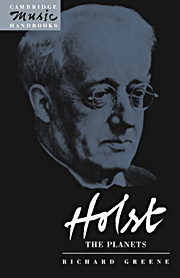Book contents
- Frontmatter
- Contents
- Acknowledgements
- Introduction
- 1 Holst and the two Londons
- 2 Genesis
- 3 Reception
- 4 The character plots (1): Mars to Mercury
- 5 The character plots (2): Jupiter to Neptune
- 6 On becoming The Planets: the overall design
- Epilogue
- Appendices
- 1 Holst's public performances, 1908–21
- 2 Comparison of tempos in selected recordings of The Planets
- Notes
- Select bibliography
- Index
2 - Comparison of tempos in selected recordings of The Planets
Published online by Cambridge University Press: 21 November 2009
- Frontmatter
- Contents
- Acknowledgements
- Introduction
- 1 Holst and the two Londons
- 2 Genesis
- 3 Reception
- 4 The character plots (1): Mars to Mercury
- 5 The character plots (2): Jupiter to Neptune
- 6 On becoming The Planets: the overall design
- Epilogue
- Appendices
- 1 Holst's public performances, 1908–21
- 2 Comparison of tempos in selected recordings of The Planets
- Notes
- Select bibliography
- Index
Summary
Concerning the chart
The recordings used in the comparison chart were chosen with an eye toward variety of tempo markings, while trying to cover the full recording history of The Planets. The collection includes English, continental and American orchestras and conductors. Inclusion here is not meant to convey a judgment of quality; rather, the main purpose of the chart is to demonstrate the range of tempos used by conductors in their interpretation of musical character. The points within the music used for comparison were chosen following those used by Imogen in her listing of tempos and timings for her father's 1922–4 recordings (found in the facsimile score [Faber, 1974]). Some of her points were not used here, if they provided no interesting comparisons (Venus: m. 60, m. 85), and I added some which provided more interpretive details (Mercury: m. 83, m. 157; Jupiter: m. 226). As Imogen states in her remarks, many of the tempos are approximations (especially in the slow movements), due to expressive license. Tempo variance of two points either way should be considered equivalent. The tempos listed for the Holst recording are based on my own measurements and vary, sometimes significantly, from Imogen's list.
Concerning the Holst recording, Imogen states that the performance sounds hurried but that the tempos are not really much faster than those used by the composer in concert. In fact, the Holst tempos for the faster movements are surpassed on the chart only once: in Jupiter/234, a transitional passage.
- Type
- Chapter
- Information
- Holst: The Planets , pp. 90 - 92Publisher: Cambridge University PressPrint publication year: 1995



